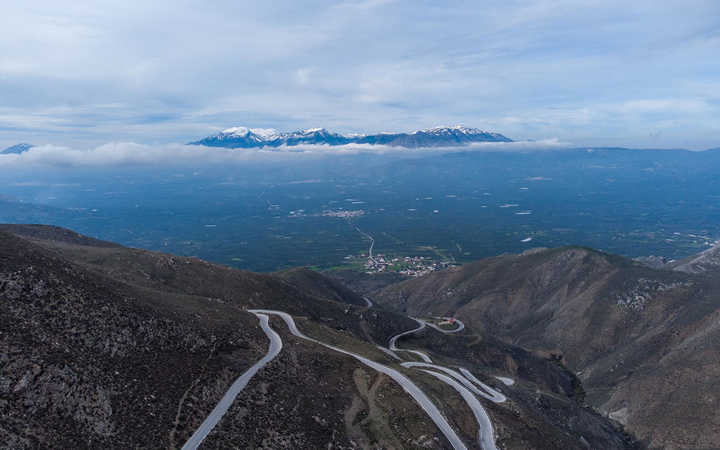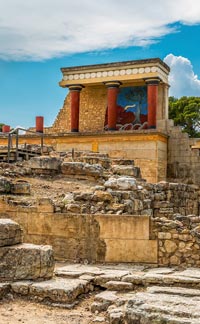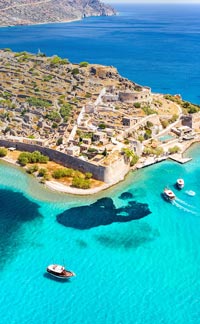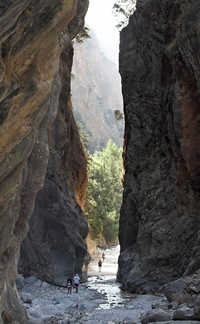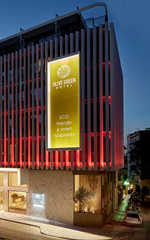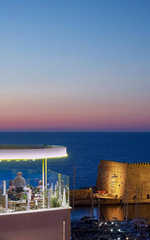Forming a 10 kilomeeter-wide, fringe-like barrier between the Libyan Sea and the Mesara Plain on the south and north, respectively, the Asterousia Mountains in south-central Crete run east and west for about 50 km. They have long served as an impediment to invasion from the sea for the inhabitants of the Mesara Plain.
The mountains form an independent range from the larger in area, higher in elevation Psiloritis Mountains to the northwest. For the most part the mountains come right down to the water's edge, with no intervening coastal plain. Another name for these mountains is the Kofinas Range, named after its highest peak, Mt. Kofinas (1231 m), found at the approximate mid-point.
The mountains are named after a local mythological king, Asterion, who was commanded to marry Princess Europa by Zeus after Zeus had had his way with her and she had borne him 3 sons. One of these sons, Rhadamathys, became king of ancient Phaistos, which is just off the northern slopes of the range towards its east end (the other two sons, Minos and Sarpedon, became the kings of Knossos and Malia.).
This is one of the most arid areas in Crete, with no rainfall in the summer and only about 7 cm total during the winter. Temperatures, which are generally high all year round, are moderated in the summer by steady winds out of the north, and in the winter by winds from Africa.
Geomorphologically (and isn't that a mouthful), the mountains are mostly bare, with many of the sheer faces favored by rock climbers, with caves, and gorges running southward to the Libyan Sea. The vegetation varies from thorny shrubs to inedible aromatics.
The mountains are home to raptors, vultures and eagles, including endangered species such as the bearded vulture, recognizable by its thick, rust-colored neck, breast and leg feathers. There are golden eagles, the peregrine falcons, and other species of falcons and eagles. In all there are about 200 species, about half of which are migratory, passing through in the spring and autumn.
The Asterousia Mountains are part of the EU's Natura 2000 network. These are nature protected areas of natural or archeological significance. Tourism is still in many ways in its infancy in this part of Greece, but it is growing, especially along the coast.
Places of interest include Ancient Phaistos, once one of Crete's principal cities, located at the western end of the range, (but not in the range itself) about 6 km north of the mountains, in the Mesara Plain. Gourtyn is another interesting archeological site to the east of Phaistos, and also in the Mesara Plain. It served as the capital of Roman Crete in the 1st century, BC. Lendas, on the shores of the Libyan Sea, once was known for its healing waters, and was home to an Aesculapium, a temple of healing. Some of the mountain villages are beginning to develop tourist facilities, such as Kapataniana, which offers a magnificent view of the Libyan Sea from the nearby summit of Mt. Kofinas, and Ethia, whose inhabitants been hard at work restoring many of its traditional Cretan mountain homes.The remoteness and aridity of the mountains have always served as a magnet for hermits and ascetics, particularly in Agiofarango Gorge, which was once home to upwards of 300 hermits. The Koudoumas Monastery, on the coast not far from Kapetaniana, is accessible only by a lengthy, unpaved road, but the trip is worth it. After visiting, you can swim in the sea where the monastery walls act as a windbreak on breezy days.
The Asterousia Mountains offer as remote a getaway as you could ask for in Crete.

